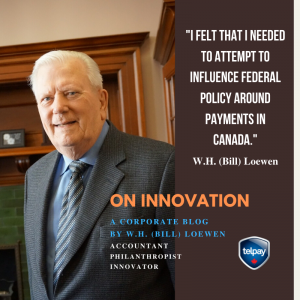 In 1968, I received a brochure proposing that I take on the franchise for a service that provided a group of accounting systems. What I found interesting about the offer was that it included all the usual accounting reports except payroll. That was the very application I was looking for but I never could find an offering that made me want to buy the service.
In 1968, I received a brochure proposing that I take on the franchise for a service that provided a group of accounting systems. What I found interesting about the offer was that it included all the usual accounting reports except payroll. That was the very application I was looking for but I never could find an offering that made me want to buy the service.
I could easily imagine reasons why others wouldn’t want to jump into providing that service. The computer programs were complicated. The processing was a bit cumbersome because of the need to produce separate cheque forms for each customer. There were fairly efficient manual systems that were widely used. But still, it seemed like an attractive application for computers because the entry of a small amount of data-enabled production of significant output, the ideal combination for computer applications.
I mulled this question over for a few days when suddenly an idea struck. What if you produced a system that drew all the payments on the same bank account? A whole list of added benefits would follow. Computer operations would be simplified and significantly speeded up. Cost of forms would be reduced. Separate forms would not have to be stored. Bank charges would be eliminated if you allied with a bank or trust company for handling the funds and clearing the cheques. Cheques did not have to be individually signed. Individual bank reconciliations would be eliminated. The interest earned on the float required to be in place until cheques cleared provided unseen revenue to cover some of our added costs. When you added it all up, the combination certainly looked like a winner.
A Simple Idea Becomes Comcheq
That simple idea was what made Comcheq the success it became. Though I knew the ins-and-outs of payroll production, I had a lot to learn about computer programming. But once learned, it became a huge benefit. Not long after I started Comcheq, the banks became my competitors. That was scary but I knew more about payroll than they did. In fact, I knew very little about computers but a fair bit about payroll and payment systems. It was easier for me to learn computer skills than for bankers to learn the intricacies of payroll. In 1968, Comcheq processed its first live payroll that integrated the payroll and payment functions.
In 1985, Telpay processed its first telephone initiated bill payment. It also integrated the payment details with the payment itself. In all the time since, very little has changed as far as bill payment is concerned other than as financial institutions adopted our systems and their volumes increased we adapted to the next stage of development of that service. First, we provided services directly to individuals. Next, the banks and credit unions took the services we provided in-house. Anticipating that we moved on to do the really hard job of serving payments for businesses.
Today the vast majority of payroll payments are processed by electronic file generated by the payroll software. Each year in Canada, hundreds of millions of bills are paid electronically with the payment details delivered by various means depending on the flexibility of the payment service provider. The banks are minor players in the business-to-business payments area.
In the mid-nineties, the big five Canadian Banks all sold their payroll services to ADP and Ceridian. They realized that payroll required too much expertise and too much of their computing resources for it to be attractive to them. Though they are strong in the electronic payments for certain types of payments that are quite simple to handle, they will be unlikely to want to tackle all the complexities of dealing with the requirements of businesses.
As TelPay began to be profitable, we started our research and development department. We could see many new possibilities in the payment field and the infrastructure we had developed for payroll payments gave us a leg up in the development of those services.
Influencing Public Policy Around Payments
Because of the experience of Comcheq and Telpay behind me, I felt that I needed to attempt to influence the direction of federal policy around payments in Canada. In the early 1980’s, the federal government created the Canadian Payments Act and what is now known as Payments Canada. It is dominated by the major banks who also fund it. We had been involved with Payments Canada for years with representation on its board but were removed for objecting to certain developments related to bill payment processing. That’s another story.
Only the federal Department of Finance can make changes that may be contrary to the interests of the banks. It is now in the process of attempting to do that with its consultative committee called Finpay. The objective of FinPay is to make the payment system more competitive as well as to catch up with technological advances. FinPay has excellent objectives and Telpay is immersed as a member of the committee that meets bi-annually in Ottawa. But it could be an old movie as I see it. Will they survive the insider and political influence of the banks? That remains to be seen.
FinPay’s first positive change resulted in a third daily exchange of payments between banks so that cheques can be processed much faster. One simple change by Payments Canada could hand Canadian businesses a few billion dollars of free working capital just by clearing cheques faster. Other changes could have major impacts in other ways. Some of what we see benefitting us all will be covered in the coming blog posts.
Thanks for reading. Please let me know if you have questions or comments.
“On Innovation” is a corporate blog by W. H. (Bill) Loewen — founder, Comcheq Payroll Services and Telpay Bill Payment Services — exploring the impact of current innovations in the financial services industry and reflections from his past 50 years of business experience. In his spare time, Bill likes to spend time with family and friends, play bridge, dabble with woodworking and is a passionate classical music lover.

Hello Bill,
You hired me as wet behind the ears chief accountant at CESSCO many years ago. Your payroll system became part of the accounting system in all companies where I was employed. Ironically the first installation took some convincing by our sales staff to buy into the comcheq system as I had no idea your were the master mind behind the system.
I hope you and your family are keeping well